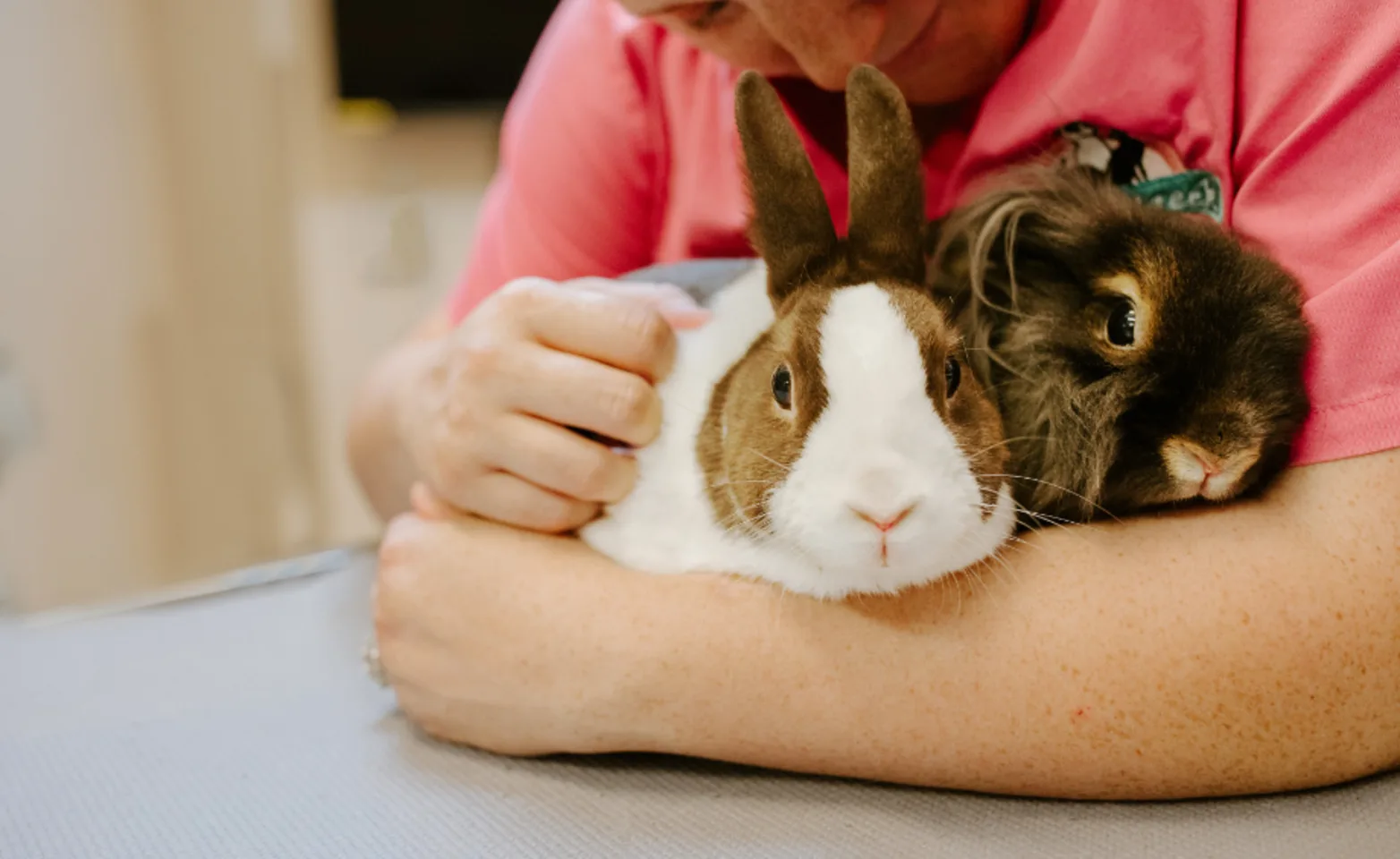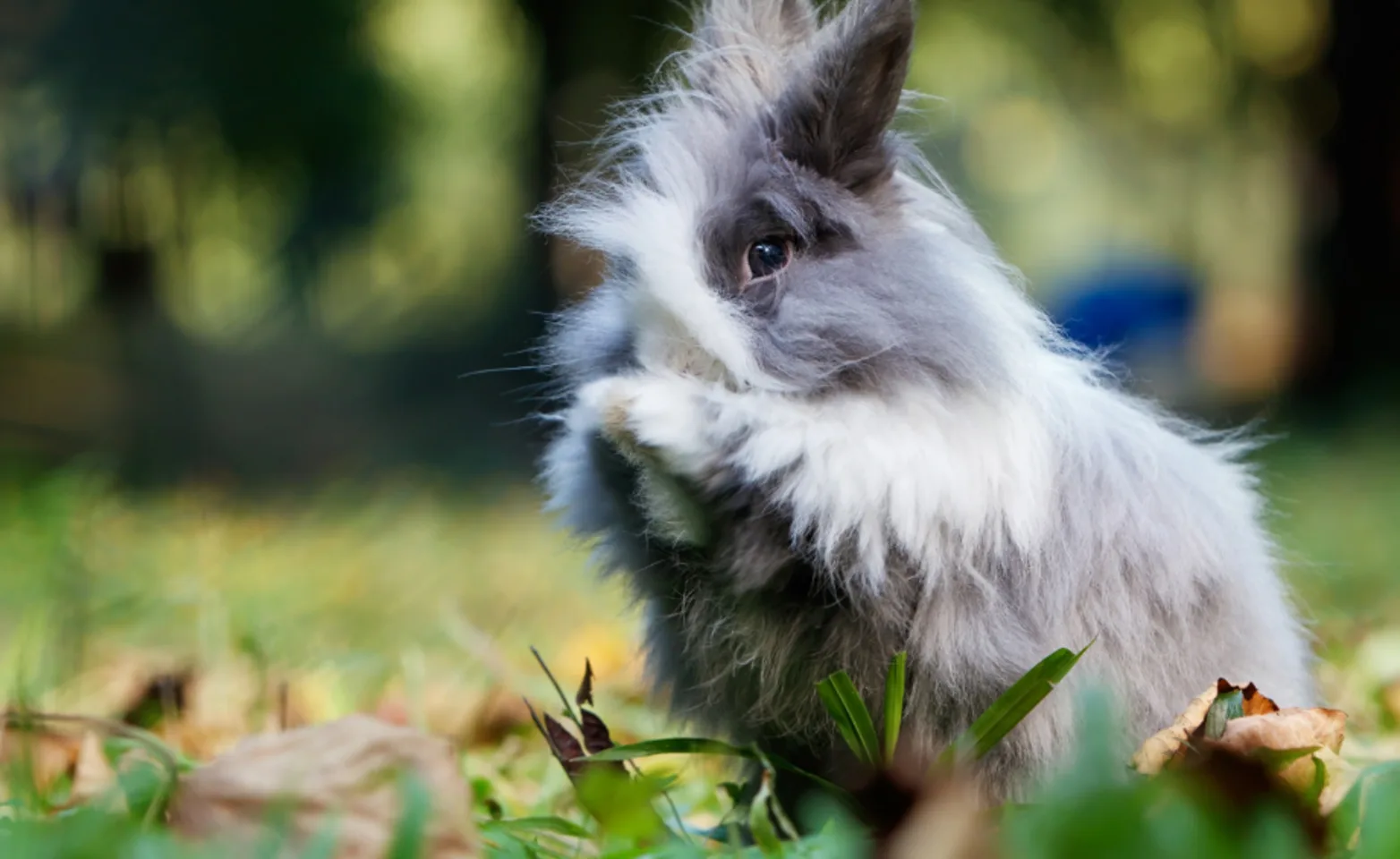Warren Woods Veterinary Hospital

Rabbits: Basic Care and Husbandry
Rabbits were first domesticated in the Middle Ages as a source of food, fur, wool, research subjects and as pets. Today there are many varieties of domestic rabbits, with different coat colors, fur types and sizes ranging from three pounds to over twenty pounds. The average life span of a rabbit in captivity is 5-8 years. Rabbits are typically very sweet, curious critters and can be great pets with the proper care and diet!
Basic Care and Husbandry
Housing
Rabbits are active and require a large amount of ground space in which to run and play every day. A cage, small mammal pen or large dog crate with wire siding for proper ventilation may be used. Rabbit owners often make their own cages out of interlocking storage cubes. There are many pictures and examples online explaining how to do this. Wire or mesh bottoms may cause sores on the rabbit’s feet, so a solid bottom cage or resting area is needed. Bigger is better when it comes to cage sizes. A rabbit’s cage should be 4-6 times the length of the rabbit when the rabbit is lounging out. Any time spent outside of the cage should be done in a supervised “bunny-proofed” area of the home. Rabbits are very curious and love to explore and chew their surroundings. All wires should be removed from the space or covered with hard plastic sleeves, baseboards and moldings should be covered with plastic guards, houseplants and other potentially hazardous objects should be removed. It is ideal to choose an area of the home that does not have carpet, rugs, drapes, or furniture that can be chewed or small spaces that your rabbit may escape into.
Time spent outdoors should always be supervised. It can take just a few seconds for your rabbit to jump a fence or predators such as possums, raccoons, skunks, coyotes, dogs or cats to enter. First inspect the yard for any poisonous plants and ensure it was not sprayed with pesticides or fertilizers. Rabbits kept in an outdoor hutch or enclosure should be kept safe from predators and exposure from the elements (sun, heat, cold, wind and rain). Rabbits do not tolerate heat well, so it is ideal they are kept indoors. Life in an outdoor hutch can be boring for your rabbit so it is important to provide an exercise area and enrichment. Rabbits spending time outdoors should be closely monitored and inspected daily and kept clean. Rabbits with wounds or open sores or those kept in dirty conditions are more susceptible to infections, parasites, maggot infestation and disease.
Recycled paper products or shredded paper is the ideal bedding choice for a rabbit cage. Pine or cedar shavings are not recommended as the dust and aromatic oils in the shavings can be irritating to the respiratory tract, eyes, and paws. Bedding should be changed and the cage should be thoroughly cleaned with a mild soap or disinfectant weekly or as needed to keep the environment clean.
Litterbox Training
Rabbits naturally choose a few places to urinate/defecate, often making litterbox training easy. For litter, use recycled paper bedding and avoid clay-based or clumping litters, as these can cause harm to your rabbit’s respiratory and gastrointestinal systems. To begin, start with a small area and place the litterbox where the rabbit chooses to go, which is usually in a corner of their enclosure. If your rabbit urinates/defecates outside the box place the paper towel used to clean the accident and the feces in the litterbox. This helps let the rabbit know that the litterbox is where they should be urinating/defecating. If you can anticipate when your rabbit is going to urinate/defecate (they may lift their tail or shimmy down) gently guide them in the litterbox. Rabbits often eat and defecate at the same time. Positioning the hay next to or over the litter box using a hay rack will encourage your rabbit to hop into the litterbox to reach the hay and subsequently use the litterbox. Never punish your rabbit for going outside the box - they will not be 100% perfect and will sometimes have small accidents. Once your rabbit has mastered using the litterbox and graduated to a larger area, be sure to increase the number of litterboxes to accommodate the larger space.
Diet
Rabbits are grazing herbivores and eat grass, hay and other foliage. An ideal rabbit diet is comprised of fresh free choice grass hay, fresh vegetables and a small amount of pellets. Hay is important for rabbits because it provides the essential fiber needed for good digestive health and dental health by helping wear down their continuously growing teeth. Alfalfa hay is appropriate for growing rabbits younger than eight months and pregnant or lactating rabbits. It should only be given in limited quantities to adult rabbits older than eight months of age because the high calcium and protein levels in alfalfa may contribute to urinary stone formation requiring future surgery. There are a variety of grass hays available to feed adult rabbits including timothy, orchard grass, and Bermuda grass hays. Make sure when purchasing a hay, it looks and smells fresh. Hay should be stored in a cool, dry, dark place and in a container that allows air flow to keep it as fresh as possible and help prevent it from getting moldy.
Dark leafy greens and vegetables should be fed at a rate of 1 cup per 4# of body weight per day. These include sprouts, basil, beet green tops, bok choy, brussels sprouts, carrot tops, cilantro, clover, collard greens, dandelion greens, dill, endive, escarole, green bell peppers, mustard greens, parsley (not curly), romaine lettuce and spinach. Avoid kale, broccoli and cauliflower as these vegetables can cause health issues. Fresh food should be removed from the cage if not eaten within a few hours to prevent rotting. Avoid sudden or drastic changes to the diet as this too may lead to diarrhea.
Pellets should be offered at a rate of 1/4 cup per 5# of body weight per day. Choose a high quality pellet with high fiber (20-25%) fiber and low protein (14-15%). Like hay, alfalfa based pellets should only be offered to growing rabbits younger than eight months of age and pregnant or lactating rabbits. Timothy based pellets should be offered to adult rabbits older than eight months of age. A common mistake rabbit owners make is feeding too many pellets. The less pellets that are offered, the more hay your rabbit will eat, which it turns promotes better-long-term dental and GI health.
Treats are fun to give but should be done in moderation. Do not offer your rabbit items that are high in carbohydrates such as breads, crackers, pasta, pretzels, cookies, chips and cereals. Avoid commercial rabbit treats as they are often high in fat and sugar. Chocolate, alcohol, caffeinated beverages, avocado, garlic, onions, nuts and potatoes are toxic to rabbits, along with numerous houseplants. Seek more information before offering your rabbit a treat or plant if you are not sure if it is safe. Safe treats that may be offered in moderation once to twice weekly include; strawberries, raspberries, bananas, apples (no seeds), papayas, peaches, blueberries, pears, melons, plums and mangos. Other safe treats that also promote dental and gastrointestinal health are timothy hay-based treats.
Your rabbit should always have access to a clean water source. A heavy ceramic dish is recommended rather than a water bottle so it’s easier for your rabbit to drink. This dish should be kept clean and refilled daily.
Toys and Activity
Rabbits can get bored very quickly if not provided proper enrichment. Homemade toys and those purchased at your local pet supply store are a great way to keep your rabbit entertained and happy. Toys are also a great way to redirect a bored rabbit from destroying items in your home. A rabbit’s teeth are constantly growing so they enjoy toys they can chew. Other tasks they relish are digging, climbing, flinging, hiding and running through tunnels. Homemade toys can include cardboard boxes (be sure to remove any tape or stickers), toilet paper rolls stuffed with timothy hay, apple wood, willow, aspen branches, non-treated baskets, compressed hay cubes, paper bags, cat toys and dried out pine cones. Avoid toys made with the following poisonous wood cherry, peach, apricot, plum, redwood. Try a variety of toys - not all bunnies like the same things; and change your toys around, offering different things to play with, to help eliminate monotony.
Handling
The first rule for handling your rabbit is to remember that they have a very fragile skeletal system and may be easily injured with improper handling and stress. Young children and inexperienced keepers should always be supervised when handling rabbits. Never attempt to lift them by their ears, scruff, legs or tail. Begin by slowly approaching the rabbit and getting down to their level to help calm the rabbit. When you are ready to lift the rabbit, scoop him/her up by placing one hand under their chest and the other under their hindquarters and pull them close to your body. Always keep their hind end and legs secure and their backs supported. Covering their eyes with a towel or your hand may help to minimize their stress. When placing the rabbit back down or into their cage you will need to be careful not to let them jump out of your arms. Hold the rabbit firmly until its feet are on the ground and be aware that once released, they will usually kick backwards.
Health Care
Most rabbits reach sexual maturity between 3 and 8 months of age. It is recommended to have your rabbit spayed/neutered by this age. Spaying females and neutering males eliminate the risk of fast-growing reproductive cancers and unwanted pregnancies. It may also help decrease unwanted marking behaviors, lessen chewing behaviors, decrease territorial aggression, improve litterbox habits and leads to a happier, longer life.
Along with proper diet and care, an annual examination, blood work and fecal check are vital for the health of your rabbit. Unlike cats and dogs, rabbits do not require vaccinations. Rabbits can get external parasites and may be placed on monthly topical preventatives. See your veterinarian before applying preventatives as some products such as Frontline Plus are toxic to rabbits. Common health concerns for rabbits include malocclusion or dental disease, intestinal parasites, gastro-intestinal stasis, bladder stones, a parasite called E. Cuniculi, hairballs (trichobezoar), Pasteurellosis and Tularemia.

Additional Resources
myhouserabbit.com
rabbit.org
oxbowanimalhealth.com
